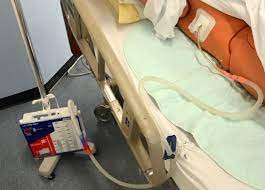A nurse is educating a newly licensed nurse about the side effects of medications.
Which medication can lead to constipation?
Iron supplements
Magnesium-containing antacids
Anticholinergics/Antispasmodics
Opioid narcotics
The Correct Answer is A
Choice A rationale:
Iron supplements Iron supplements are commonly used to treat or prevent iron deficiency anemia. While beneficial in relieving iron deficiency, iron pills can cause side effects like constipation, diarrhea, nausea, vomiting, dark stools, stomach cramps, and a metallic taste. However, constipation is not the primary side effect of iron supplements.
Choice B rationale:
Magnesium-containing antacids Magnesium-containing antacids are used to relieve the symptoms of gastroesophageal reflux disease (GERD), heartburn, or indigestion. By neutralizing stomach acid, antacids relieve symptoms such as burning behind the breast bone or throat area caused by acid reflux, a bitter taste in the mouth, a persistent dry cough, pain when lying down, or regurgitation. While these antacids can cause diarrhea, they do not typically lead to constipation.
Choice C rationale:
Anticholinergics/Antispasmodics Anticholinergics and antispasmodics are used to relieve cramps or spasms of the stomach, intestines, and bladder. Some are used together with antacids or other medicines in the treatment of peptic ulcers. Others are used to prevent nausea, vomiting, and motion sickness. While these medications can cause a variety of side effects, constipation is not a primary side effect.
Choice D rationale:
Opioid narcotics Opioids, also known as narcotics, are a class of drugs healthcare providers prescribe to manage moderate to severe pain, as well as chronic coughing and diarrhea. Common side effects of narcotics include constipation, decreased sweating, dizziness, dry mouth, nose, throat, or skin. Therefore, opioid narcotics are the medication most likely to lead to constipation among the options provided.
Nursing Test Bank
Naxlex Comprehensive Predictor Exams
Related Questions
Correct Answer is D
Explanation
Choice A rationale:
Stripping the client’s chest tube every 2 hours is not recommended. Stripping can create high negative pressures in the tube that can cause damage to the lung tissue. It can also lead to increased pain for the patient and is generally not a standard practice in chest tube management.
Choice B rationale:
Looping the tubing of the chest tube on the client’s bed is not a recommended practice. The chest tube should be free of loops or kinks to allow for proper drainage of air and fluid from the pleural space. Any loops or kinks in the tube can lead to accumulation of fluid or air, which can cause complications such as tension pneumothorax.
The chest tube drainage system should not be placed above the level of the client’s heart. This can lead to the backflow of blood or fluid into the pleural space, which can cause complications such as hemothorax or pleural effusion. The drainage system should always be kept below the level of the client’s chest to allow for gravity-assisted drainage.
Choice D rationale:
Taping the connections on the client’s chest tube is a recommended practice. This is done to secure the connections and prevent accidental disconnection or dislodgement of the tube. An accidental disconnection or dislodgement can lead to complications such as pneumothorax or hemothorax. Therefore, all connections should be securely taped to prevent any accidental disconnections.

Correct Answer is D
Explanation
Choice A rationale:
Reflex incontinence is a type of urinary incontinence that occurs when the person has no control over urination. They’re unable to feel when their bladder is full and can’t control the process of emptying it. This is often due to a brain or spinal cord injury that disrupts communication between these organs. However, this condition does not necessarily indicate the need for catheterization in a client with paraplegia who is already on an intermittent urinary catheterization program.
Choice B rationale:
Urge incontinence, also known as overactive bladder, is characterized by a sudden, intense urge to urinate, followed by an involuntary loss of urine. This condition can be caused by various factors, including neurological disorders, bladder abnormalities, and certain medications. While it can be a challenge for individuals with paraplegia, it does not directly indicate the need for catheterization.
Choice C rationale:
Nocturnal enuresis, or bedwetting, is involuntary urination while asleep. It’s a common condition, especially in young children, but it can affect individuals of any age. In the context of a client with paraplegia, nocturnal enuresis could be a symptom of a larger issue, such as a urinary tract infection or bladder dysfunction, but it does not directly indicate the need for catheterization. Choice D rationale:
Suprapubic discomfort or pain in the area above the pubic bone could be a sign of bladder distension, which is a common complication in individuals with spinal cord injuries. Bladder distension can occur when the bladder becomes overly full and can’t empty, causing discomfort or pain in the lower abdomen. This is a clear indication for the need to catheterize the client.
Whether you are a student looking to ace your exams or a practicing nurse seeking to enhance your expertise , our nursing education contents will empower you with the confidence and competence to make a difference in the lives of patients and become a respected leader in the healthcare field.
Visit Naxlex, invest in your future and unlock endless possibilities with our unparalleled nursing education contents today
Report Wrong Answer on the Current Question
Do you disagree with the answer? If yes, what is your expected answer? Explain.
Kindly be descriptive with the issue you are facing.
